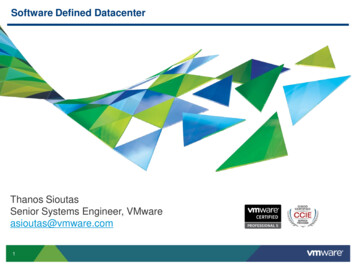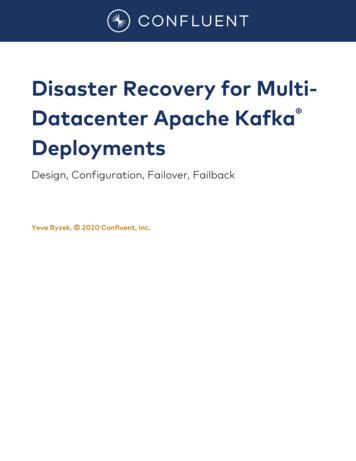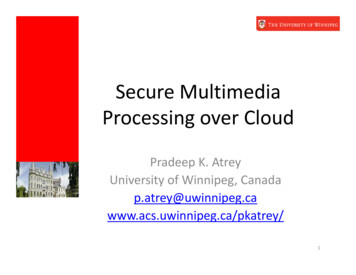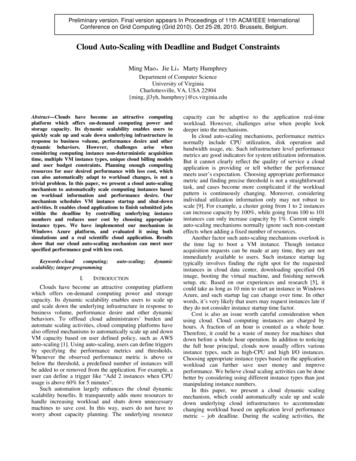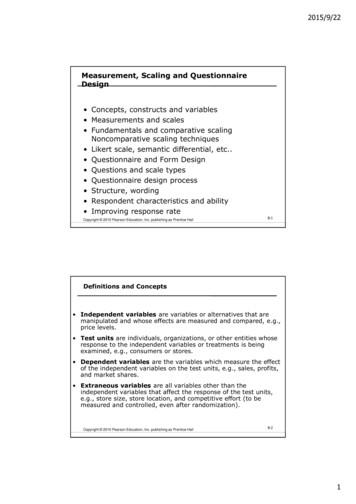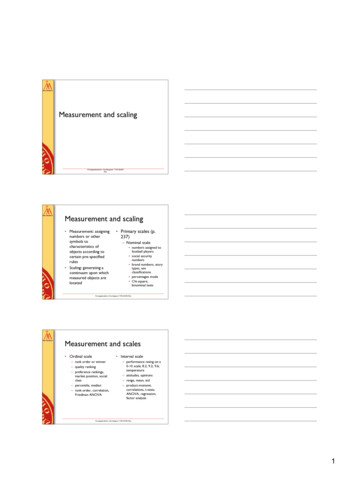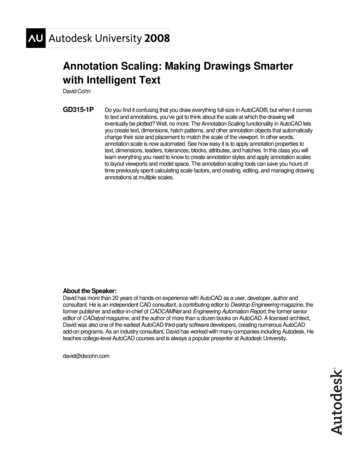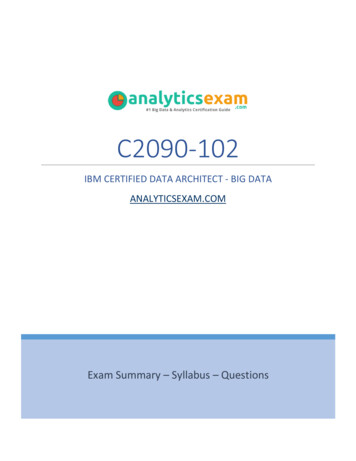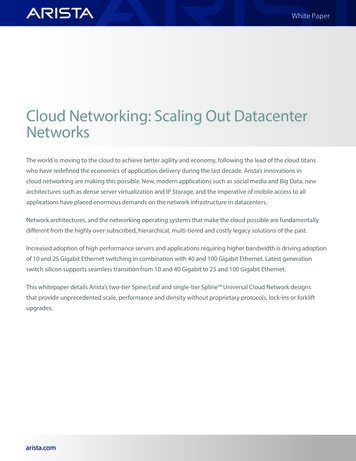
Transcription
White PaperCloud Networking: Scaling Out DatacenterNetworksThe world is moving to the cloud to achieve better agility and economy, following the lead of the cloud titanswho have redefined the economics of application delivery during the last decade. Arista’s innovations incloud networking are making this possible. New, modern applications such as social media and Big Data, newarchitectures such as dense server virtualization and IP Storage, and the imperative of mobile access to allapplications have placed enormous demands on the network infrastructure in datacenters.Network architectures, and the networking operating systems that make the cloud possible are fundamentallydifferent from the highly over-subscribed, hierarchical, multi-tiered and costly legacy solutions of the past.Increased adoption of high performance servers and applications requiring higher bandwidth is driving adoptionof 10 and 25 Gigabit Ethernet switching in combination with 40 and 100 Gigabit Ethernet. Latest generationswitch silicon supports seamless transition from 10 and 40 Gigabit to 25 and 100 Gigabit Ethernet.This whitepaper details Arista’s two-tier Spine/Leaf and single-tier Spline Universal Cloud Network designsthat provide unprecedented scale, performance and density without proprietary protocols, lock-ins or forkliftupgrades.arista.com
White PaperKey Points of Arista DesignsAll Arista Universal Cloud Network designs revolve around these nine central design goals:1.No proprietary protocols or vendor lock-ins. Arista believes in open standards. Our proven reference designs show that proprietaryprotocols and vendor lock-ins aren’t required to build very large scale-out networks2.Fewer Tiers is better than More Tiers. Designs with fewer tiers (e.g. a 2-tier Spine/Leaf design rather than 3-tier) decrease cost,complexity, cabling and power/heat. Single-tier Spline network designs don’t use any ports for interconnecting tiers of switchesso provide the lowest cost per usable port. A legacy design that may have required 3 or more tiers to achieve the required portcount just a few years ago can be achieved in a 1 or 2-tier design.3.No protocol religion. Arista supports scale-out designs built at layer 2 or layer 3 or hybrid L2/L3 designs with open multi-vendorsupported protocols like VXLAN that combine the flexibility of L2 with the scale-out characteristics of L3.4.Modern infrastructure should be run active/active. Multi chassis Link Aggregation (MLAG) at layer 2 and Equal Cost Multi-Pathing(ECMP) at layer 3 enables infrastructure to be built as active/active with no ports blocked so that networks can use all the linksavailable between any two devices.5.Designs should be agile and allow for flexibility in port speeds. The inflection point when the majority of servers/compute nodesconnect at 1000Mb to 10G is between 2013-2015. This in turn drives the requirement for network uplinks to migrate from 10Gto 40G and to 100G. Arista switches and reference designs enable that flexibility6.Scale-out designs enable infrastructure to start small and evolve over time. A two-way ECMP design can grow from 2-way to4-way, 8-way, 16-way and as far as a 32-way design. An ECMP design can grow over time without significant up-front capitalinvestment.7.Large Buffers can be important. Modern Operating Systems, Network Interface Cards (NICs) and scale-out storage arrays makeuse of techniques such as TCP Segmentation Offload (TSO), GSO and LSO. These techniques are fundamental to reducing theCPU cycles required when servers send large amounts of data. A side effect of these techniques is that an application/ OS/storage that wishes to transmit a chunk of data will offload it to the NIC, which slices the data into segments and puts themon the wire as back-to-back frames at line-rate. If more than one of these is destined to the same output port then microburstcongestion occurs.One approach to dealing with bursts is to build a network with minimal oversubscription, overprovisioning links such that theycan absorb bursts. Another is to reduce the fan-in of traffic. An alternative approach is to deploy switches with deep buffers toabsorb the bursts results in packet drops, which in turn results in lower good-put (useful throughput).8.Consistent features and OS. All Arista switches use the same Arista EOS. There is no difference in platform, software trains or OS.It’s the same binary image across all switches.9.Interoperability. Arista switches and designs can interoperate with other networking vendors with no proprietary lock-in.Design Choices - Number of TiersAn accepted principle of network designs is that a given design should not be based on the short-term requirements but insteadthe longer-term requirement of how large a network or network pod may grow over time. Network designs should be based on themaximum number of usable ports that are required and the desired oversubscription ratio for traffic between devices attached tothose ports over the longer-term.If the longer-term requirements for number of ports can be fulfilled in a single switch (or pair of switches in a HA design), thenthere’s no reason why a single tier spline design should not be used.arista.com
White PaperSpline Network DesignsSpline designs collapse what have historically been the spineand leaf tiers into a single spline. Single tier spline designswill always offer the lowest capex and opex (as there are noports used for interconnecting tiers of switches), the lowestlatency, are inherently non-oversubscribed with at most twomanagement touch points. Flexible airflow options (frontto-rear or rear-to-front) on a modular spline switch enableits deployment in server/compute racks in the data center,with ports on the same side as the servers with airflow thatFigure 1: Arista Spline single-tier network designs provide scale up to 2,000 physicalmatches the thermal containment of the servers.servers (49 racks of 1U servers)Arista 7300 Series (4/8/16 slot modular chassis), Arista 7250X Series (64x40G to 256x10G 2U Fixed switch) and Arista 7050X Series(32x40G to 104x10G 8x40G) switches are ideal for spline network designs providing for 104 to 2048 x 10G ports in a single switch,catering for data centers as small as 3 racks to as large as 49 racks.Table 1: Spline single-tier network designs *Switch PlatformMaximum Ports10GArista 7500E SeriesArista 7508EArista 7504E25G115257640G288144Arista 7320X SeriesArista 7328X w/Arista 7324X1024 1024 256512512 128Arista 7300X SeriesArista 7316XArista 7308XArista 7304X20481024512Arista 7260X & 7060XSeriesArista 7260CX-64258Arista 7260QX-642Arista 7060CX-32S1309648512256256642561283225632Arista 7050QX-32SArista 7050SX-128Arista 7050TX -128Arista 7050SX-72QArista 7050TX-72QArista 7050SX-96Arista 7050TX-96Arista 7050SX-64Arista 7050TX-64Arista 7050TX-48969696484848484848328866666444Arista 7150S SeriesArista 7150S-64Arista 7150S-52Arista 7150S-244852244 (16)(13)(6)RJ45 (100/1000/10G-T)SFP /SFP (10G/1G)QSFP (40G/4x10G)MXP (100G/3x40G/12x10G)CFP2 (100G)QSFP100 (100G)Best suited to two-tier Spine/Leaf designs but canbe used in spline designsQSFP100 (100G/4x25G/2x50G)QSFP (40G/4x10G)Best suited for larger Spline end-of-row / middleof row designs but can be used as spine intwo-tier designs with highest 10G / 40G capacityRJ45 (100/1000/10G-T)SFP /SFP (10G/1G)QSFP (40G/4x10G)Best suited for larger Spline end-of-row / middleof row designs but can be used as spine intwo-tier designs with highest 10G / 40G capacityMXP ports provide most interface speed flexibilityDeep BuffersRJ45 10GBASE-T enables seamless 100M/1G/10Gtransition12864QSFP (40G/4x10G)QSFP100 (100G/2x50G/4x25G)Best suited for midsized Spline end-of-row /middle of row designs w/ optical/DACconnectivityQSFP (40G)Not targeted at Spline designsQSFP (40G/4x10G)QSFP100 (100G/2x50G/4x25G)Best suited for small Spline end-of-row / middle ofrow designs w/ optical/DAC connectivityQSFP (40G/4x10G)Best suited for midsized Spline end-of-row /middle of row designs w/ optical/DACconnectivityRJ45 (100/1000/10G-T) [TX]SFP /SFP (10G/1G) [SX]QSFP (40G/4x10G) [QX]QSFP (40G) [SX/TX-96]MXP (3x40G) [SX/TX-72]QSFP (40G/4x10G) [SX/TX-64]QSFP (40G/4x10G) [TX-48]Best suited for small Spline end-of-row / middle ofrow designs w/ optical/DAC connectivitySFP /SFP (10G/1G)QSFP (40G/4x10G)Best suited for small Spline end-of-row / middle ofrow designs w/ optical/DAC connectivity6464128Key Switch Platform Characteristics100G512256128Arista 7250X & 7050XSeriesArista 7250QX-64arista.com50GSwitch Interface Types32
White PaperSpine/Leaf Network DesignsFor designs that don’t fit a single tier spline design then atwo-tier spine leaf design is the next logical step. A two-tierdesign has spine switches at the top tier and leaf switches at thebottom tier with Servers/compute/storage always attached toleaf switches at the top of every rack (or for higher density leafswitches, top of every N racks) and leaf switches uplink to 2 ormore spine switches.Scale out designs can start with one pair of spine switches andsome quantity of leaf switches. A two-tier leaf/spine networkdesign at 3:1 oversubscription for 10G attached devices has for96x10G ports for servers/compute/storage and 8x40G uplinksper leaf switch (Arista 7050SX-128 – 96x10G : 8x40G uplinks 3:1oversubscribed).Figure 2: Arista Spine/Leaf two-tier network designs provide scale in excessof 100,000 physical serversAn alternate design for 10G could make use of 100G uplinks, e.g. Arista 7060CX-32S with 24x100G ports running with 4x10Gbreakout for 96x10G ports for servers/compute/storage and 8x100G uplinks. Such a design would now only be 1.2:1 oversubscribed.A design for 25G attached devices could use 7060CX-32S with 24x100G ports broken out to 96x25G ports for servers/compute/storage and the remaining 8x100G ports for uplinks would also be 3:1 (96x25G 2400G : 8x100G 800G).Two-tier Spine/Leaf network designs enable horizontal scale-out with the number of spine switches growing linearly as the numberof leaf switches grows over time. The maximum scale achievable is a function of the density of the spine switches, the scale-out thatcan be achieved (this is a function of cabling and number of physical uplinks from each leaf switch) and desired oversubscriptionratio.Either modular or fixed configuration switches can be used for spine switches in a two-tier spine/leaf design however the spineswitch choice locks in the maximum scale that a design can grow to. This is shown below in table 2 (10G connectivity to leaf ) andtable 3 (25G connectivity to leaf ).Table 2: Maximum scale that is achievable in an Arista two-tier Spine Leaf design for 10G attached devices w/ 40G uplinks *Spine SwitchPlatformNo. Spine Switches Oversubscription(scale-out)Spine to LeafLeaf to SpineConnectivityLeaf Switch PlatformDesign Supports up to n LeafPorts @ 10GArista 7504E2, 4, 83:18x40GArista 7050QX-32 orArista 7050SX-12836 leaf x 96x10G 3,456 x 10G72 leaf x 96x10G 6,912 x 10G144 leaf x 96x10G 13,824 x 10GArista 7508E2, 4, 83:18x40GArista 7050QX-32 orArista 7050SX-12872 leaf x 96x10G 6,912 x 10G144 leaf x 96x10G 13,824 x 10G288 leaf x 96x10G 27,648 x 10GArista 7508E2, 4, 83:116x40GArista 725036 leaf x 192x10G 6,912 x 10G72 leaf x 192x10G 13,824 x 10G144 leaf x 192x10G 27,648 x 10G288 leaf x 19x10G 55,296 x 10GArista 7508E2, 4, 83:132x40GArista 7304X w/7300X-32Q LC18 leaf x 384x10G 6,912 x 10G36 leaf x 384x10G 13,824 x 10G72 leaf x 384x10G 27,648 x 10G144 leaf x 384x10G 55,296 x 10G288 leaf x 384x10G 110,592 x 10GArista 7316X2, 4, 83:164x40GArista 7308X w/7300X-32Q LC16 leaf x 768x10G 12,288 x 10G32 leaf x 768x10G 24,576 x 10G64 leaf x 768x10G 49,152 x 10G128 leaf x 768x10G 98,304 x 10G256 leaf x 768x10G 196,608 x 10G512 leaf x 768x10G 393,216 x 10Garista.com
White PaperTable 3: Maximum scale that is achievable in an Arista two-tier Spine/Leaf design for 25G attached devices w/ 100G uplinks *Spine SwitchPlatformNo. Spine Switches Oversubscription(scale-out)Spine to LeafLeaf to SpineConnectivityLeaf Switch PlatformDesign Supports up to n LeafPorts @ 10GArista 7508E2, 4, 83:18x100GArista 7060CX-3224 leaf x 96x25G 2,304 x 25G48 leaf x 96x25G 4,608 x 25G96 leaf x 96x25G 9,216 x 25GArista 7508E4, 8, 163:116x100GArista 7260CX-6424 leaf x 192x25G 4,608 x 25G48 leaf x 192x25G 9,216 x 25G96 leaf x 192x25G 18,432 x 25GArista 7328X4, 83:18x100GArista 7060CX-32128 leaf x 96x25G 12,288 x 25G256 leaf x 96x25G 24,576 x 25GArista 7328X4, 8, 163:116x100GArista 7260CX-6464 leaf x 192x25G 12,288 x 25G128 leaf x 192x25G 24,576 x 25G256 leaf x 192x25G 49,152 x 25GArista 7328X16, 32, 643:164x100GArista 7328X w/7320CX-32 LC64 leaf x 768x25G 49,152 x 25G128 leaf x 768x10G 98,304 x 25G256 leaf x 768x10G 196,608 x 25G512 leaf x 768x10G 393,216 x 25GDesign Considerations for Leaf/Spine Network DesignsCapex Cost Per Usable PortA design with more tiers offers higher scalability compared to a designwith fewer tiers. However it trades this off against both higher capitalexpense (capex) and operational expense (opex). More tiers meansmore devices, which is more devices to manage as well as moreports used between switches for the fan-out interconnects betweenswitches.Using a 4-port switch as an example for simplicity and using a nonoversubscribed Clos network topology, if a network required 4ports, the requirements could be met using a single switch. (This is asimplistic example but demonstrates the principle).Figure 3: Single Tier Spline compared to Two-Tier Spine/Leaf and legacyThree-Tier Core/Aggregation/AccessIf the port requirements double from 4 to 8 usable ports, and the building block is a 4-port switch, the network would grow froma single tier to two-tiers and the number of switches required would increase from 1 switch to 6 switches to maintain the nonoversubscribed network. For a 2x increase of the usable ports, there is a 3-fold increase in cost per usable port (in reality the costgoes up even more than 3x as there is also the cost of the interconnect cables or transceivers/fiber.)If the port count requirements doubles again from 8 to 16, a third tier is required, increasing the number of switches from 6 to 20,or an additional 3.3 times increase in devices/cost for just a doubling in capacity. Compared to a single tier design, this 3-tier designnow offers 4x more usable ports (16 compared to 4) but does so at over a 20x increase in cost compared to our original single switchdesign.Capital expense (capex) costs go up with increased scale. However, capex costs can be dramatically reduced if a network can bebuilt using fewer tiers as less cost is sunk into the interconnects between tiers. Operational expense (opex) costs also decreasedramatically with fewer devices to manage, power and cool, etc. All network designs should be looked at from the perspective of thecost per usable port (those ports used for servers/storage) over the lifetime of the network. Cost per usable port is calculated as:cost of switches (capex) optics (capex) fiber (capex) power (opex)total nodes x oversubscriptionarista.com
White PaperOversubscriptionOversubscription is the ratio of contention should all devices send traffic atthe same time. It can be measured in a north/south direction (traffic entering/leaving a data center) as well as east/west (traffic between devices in the datacenter). Many legacy data center designs have very large oversubscriptionratios, upwards of 20:1 for both north/south and east/west, because of thelarge number of tiers and limited density/ports in the switches but alsobecause of historically much lower traffic levels per server. Legacy designsalso typically have the L3 gateway in the core or aggregation which also forcestraffic between VLANs to traverse all tiers. This is suboptimal on many levels.Figure 4: Leaf switch deployed with 3:1 oversubscription(48x10G down to 4x40G up)Significant increases in the use of multi-core CPUs, server virtualization, flash storage, Big Data and cloud computing have driven therequirement for modern networks to have lower oversubscription. Current modern network designs have oversubscription ratios of3:1 or less. In a two-tier design this oversubscription is measured as the ration of downlink ports (to servers/storage) to uplink ports(to spine switches). For a 64-port leaf switch this equates to 48 ports down to 16 ports up. In contrast a 1:1 design with a 64-portleaf switch would have 32 ports down to 32 up.A good rule-of-thumb in a modern data center is to start with an oversubscription ratio of 3:1. Features like Arista Latency Analyzer(LANZ) can identify hotspots of congestion before it results in service degradation (seen as packet drops) allowing for someflexibility in modifying the design ratios if traffic is exceeding available capacity.10G, 40G or 100G Uplinks from Leaf to SpineFor a Spine/Leaf network, the uplinks from Leaf to Spine are typically 10G or 40G and can migrate over time from a starting pointof 10G (N x 10G) to become 40G (or N x 40G). All Arista 10G ToR switches (except 7050SX-128 and 7050TX-128) offer this flexibilityas 40G ports with QSFP can operate as 1x40G or 4x10G, software configurable. Additionally the AgilePorts feature on some Aristaswitches allows a group of four 10G SFP ports to operate as a 40G port.An ideal scenario always has the uplinks operating at a faster speed than downlinks, in order to ensure there isn’t any blocking dueto micro-bursts of one host bursting at line-rate.Two-Tier Spine/Leaf Scale-Out Over TimeScale out designs typically start with two spine switches and somequantity of leaf switches. To give an example of how such a design scalesout over time, the following design has Arista 7504E modular switches atthe spine and Arista 7050SX-64 at the leaf in a 3:1 oversubscribed design.Each leaf switch provides 48x10G ports for server/compute/storageconnectivity and has 16x10G total uplinks to the spine, split into twogroups of 8x10G active/active across two spine switches.Figure 5: Starting point of a scale-out design: one pair of switcheseach with a single linecardWith a single DCS-7500E-36Q linecard (36x40G / 144x10G) in each spineswitch, the initial network expands to enable connectivity for 18 leafswitches (864 x 10G attached devices @ 3:1 oversubscription end-to-end)as shown in Figure 5.As more leaf switches are added and the ports on the first linecard of thespine switches are used, a second linecard is added to each chassis andhalf of the links are moved to the second linecard. The design can growfrom 18 leaf switches to 36 leaf switches (1,728 x 10G attached devices @3:1 oversubscription end-to-end as shown in Figure 6.Figure 6: First expansion of spine in a scale-out design: secondlinecard moduleThis process repeats a number of times over. If the uplinks between the leaf and spine are at 10G then each uplink can be distributedacross 4 ports on 4 linecards in each switch.arista.com
White PaperThe final scale numbers of this design is a function of the port scale/density of the spine switches, the desired oversubscription ratio and thenumber of spine switches. Provided there are two spine switches thedesign can be built at layer 2 or layer 3. Final scale for two Arista 7504Espine switches is 72 leaf switches or 3,456 x 10G @ 3:1 oversubscriptionend-to-end. If the design used a pair of Arista 7508E switches then it isdouble that, i.e., 144 leaf switches for 6,912 x 10G @ 3:1 oversubscriptionend-to-end as shown in Figure 7.Figure 7: Final expansion of spine in a scale-out design: add a fourthlinecard module to each Arista 7504E25G or 50G UplinksFor Arista switches with 100G ports that support 25G and 50G breakout, 25G and 50G provides the means of taking 100G ports andbreaking them out to 4x25G or 2x50G enabling a wider fan-out for Layer 3 ECMP designs. This can be used to increase the number ofspine switches in a scale-out design enabling both more spine and therefore more leaf switches through a wider fan-out.Layer 2 or Layer 3Two-tier Spine/Leaf networks can be built at either layer 2 (VLAN everywhere) or layer 3 (subnets). Each has their advantages anddisadvantages.Layer 2 designs allow the most flexibility allowing VLANs to span everywhere and MAC addresses to migrate anywhere. Thedownside is that there is a single common fault domain (potentially quite large), and as scale is limited by the MAC address tablesize of the smallest switch in the network, troubleshooting can be challenging, L3 scale and convergence time will be determined bythe size of the Host Route table on the L3 gateway and the largest non-blocking fan-out network is a spine layer two switches wideutilizing Multi-chassis Link Aggregation (MLAG).Layer 3 designs provide the fastest convergence times and the largest scale with fan-out with Equal Cost Multi Pathing (ECMP)supporting up to 32 or more active/active spine switches. These designs localize the L2/L3 gateway to the first hop switch allowingfor the most flexibility in allowing different classes of switches to be utilized to their maximum capability without any dumbingdown (lowest-common-denominator) between switches.Layer 3 designs do restrict VLANs and MAC address mobility to a single switch or pair of switches and so limit the scope of VMmobility to the reach of a single switch or pair of switches, which is typically to within a rack or several racks at most.Layer 3 Underlay with VXLAN OverlayVXLAN complements the Layer 3 designs by enabling a layer 2 overlay across layer 3 underlay via the non-proprietary multi-vendorVXLAN standard. It couples the best of layer 3 designs (scale-out, massive network scale, fast convergence and minimized faultdomains) with the flexibility of layer 2 (VLAN and MAC address mobility), alleviating the downsides of both layer 2 and layer 3designs.VXLAN capabilities can be enabled in software via a virtual switch as part of a virtual server infrastructure. This approach extendslayer 2 over layer 3 but doesn’t address how traffic gets to the correct physical server in the most optimal manner. A softwarebased approach to deploying VXLAN or other overlays in the network also costs CPU cycles on the server, as a result of the offloadcapabilities on the NIC being disabled.Hardware VXLAN Gateway capabilities on Arista switches enable the most flexibility, greatest scale and traffic optimization. Thephysical network remains at layer 3 for maximum scale-out, best table/capability utilization and fastest convergence times. Serverscontinue to provide NIC CPU offload capability and the VXLAN Hardware Gateway provides layer 2 and layer 3 forwarding, alongsidethe layer 2 overlay over layer 3 forwarding.arista.com
White PaperTable 4: Pros/Cons of Layer 2, Layer 3 and Layer 3 with VXLAN designsDesign TypeProsConsLayer 2VLAN everywhere provides most flexibilitySingle (large) fault domainMAC mobility enables seamless VM mobilityRedundant/HA links blocked due to STPChallenging to extend beyond a pod or data centerwithout extending failure domainsL3 gateway convergence challenged by speed of controlplane (ARPs/second)L3 scale determined by Host route scale @ L3 gatewayScale can be at most 2-way wide (MLAG active/active)Maximum Number of VLANs x Ports on a switch limitedby Spanning Tree Logical Port Count ScaleChallenging to TroubleshootLayer 3Extends across pods or across data centersVLAN constrained to a single switchVery large scale-out due to ECMPMAC mobility only within a single switchVery fast convergence/ re-convergence timesLayer 3 Underlaywith VXLAN OverlayVXLAN allows a VLAN to be extended to any switch/deviceMAC mobility anywhere there is L3 connectivitySoftware/hypervisor virtual switch based VXLAN imposesCPU overhead on host (hardware VXLAN gateways do nothave this trait)Extends across pods or across data centersMAC mobility enables seamless VM mobilityVery large scale-out due to ECMPVery fast convergence/re-convergence timesArista switch platforms with hardware VXLAN gateway capabilities include: all Arista switches that have the letter ‘E’ or ‘X’ (Arista7500E Series, Arista 7280E, Arista 7320X Series, Arista 7300E Series, Arista 7060X Series, Arista 7050X Series) and Arista 7150S Series.These platforms support unicast-based hardware VXLAN gateway capabilities with orchestration via Arista CloudVision, via openstandards-based non-proprietary protocols such as OVSDB or via static configuration. This open approach to hardware VXLANgateway capabilities provides end users choice between cloud orchestration platforms without any proprietary vendor lock-in.Forwarding Table SizesEthernet switching ASICs use a number of forwarding tables for making forwarding decisions: MAC tables (L2), Host Route tables (L3)and Longest Prefix Match (LPM) for L3 prefix lookups. The maximum size of a network that can be built at L2 or L3 is determined bythe size of these tables.Historically a server or host had just a single MAC address and a single IP address. With server virtualization this has become at least1 MAC address and 1 IP address per virtual server and more than one address/VM if there are additional virtual NICs (vNICs) defined.Many IT organizations are deploying dual IPv4 / IPv6 stacks (or plan to in the future) and forwarding tables on switches must takeinto account both IPv4 and IPv6 table requirements.If a network is built at Layer 2 every switch learns every MAC address in the network, and the switches at the spine provide theforwarding between layer 2 and layer 3 and have to provide the gateway host routes.If a network is built at Layer 3 then the spine switches only need to use IP forwarding for a subnet (or two) per leaf switch and don’tneed to know about any host MAC addresses. Leaf switches need to know about the IP host routes and MAC addresses local to thembut don’t need to know about anything outside the local connections. The only routing prefixes leaf switches require is a singledefault route towards the spine switches.arista.com
White PaperFigure 8: Layer 2 and Layer 3 Designs contrastedRegardless of whether the network is built at layer 2 or layer 3 it’s frequently the number of VMs that drives the networking tablesizes. A currently modern x86 server is a dual socket with 6 or 8 CPU cores/socket. Typical enterprise workloads allow for 10 VMs/CPU core, such that for a typical server to have 60-80 VMs running is not unusual. It is foreseeable that this number will only getlarger in the future.For a design that is 10 VMs/CPU, quad-core CPUs with 2 sockets/server, 40 physical servers per rack and 20 racks of servers, thiswould drive the forwarding table requirements of the network as follows:Table 5: Forwarding Table scale characteristics of Layer 2 and Layer 3 DesignsForwarding TableLayer 2 Spine/Leaf DesignSpine SwitchesLayer 3 Spine/Leaf DesignLeaf SwitchesSpine SwitchesLeaf SwitchesMinimal1 MAC Address/VM xMAC Address(1 vNIC / VM)1 MAC Address/VM x10 VMs/CPU x 4 CPUs/socket xIP Route LPMSmall number ofIP PrefixesNone1 subnet per rack x(Leaf switch operating atL2 has no L3)20 racks 1 IPv4 host route/VMNoneMinimal1 IPv4 host route/VM3200 IPv4 host routes/rack x 20 racks (Leaf switch operating atL2 has no L3)(No IP Host Routes inSpine switches)3200 IPv4 host routes/rack NoneMinimal(Leaf switch operating atL2 has no L3)(No IP Host Routes inSpine switches)1 IPv4 and IPv6 Host route/VM2 sockets per server 80 VMs/server x 40 servers/rack (Spine switches operating 10 VMs/CPU x 4 CPUs/socketat L3 so L2 forwardingx 2S 3,200 MAC addresses/rack x 20 racks table not used)80 VMs/server x 40 servers/64K MAC addressesrack 3,200 MAC addressesIP Host Route(IPv4 only)(Single ECMP route towards20 IP Route LPM prefixes Spine switches)64K IP Host routesIP Host Route(IPv4 IPv6 dualstack)1 IPv4 and IPv6 Hostroute/VM64K IPv4 Host Routes 64K IPv6 Host Routesarista.comMinimal3200 IP Host routes3200 IPv4 Host Routes 3200 IPv6 Host Routes
White PaperLayer 2 Spanning Tree Logical Port Count ScaleDespite the common concerns with large layer 2 networks (large broadcast domain, single fault domain, difficult to troubleshoot),one limiting factor often overlooked is the control-plane CPU overhead associated with running the Spanning Tree Protocol onthe switches. As a protocol, Spanning Tree is relatively unique in that a failure of the protocol results in a ‘fail open’ state rather thanthe more modern ‘fail closed’ state. If there is a protocol failure for some reason, there will be a network loop. This characteristic ofspanning tree makes it imperative that the switch control plane is not overwhelmed.With Rapid Per VLAN Spanning Tree (RPVST), the switch maintains multiple independent instances of spanning tree (for each VLAN),sending/receiving BPDUs on ports at regular intervals and changing the port state on physical ports from Learning/Listening/Forwarding/Blocking based on those BPDUs. Managing a large number of non-synchronized independent instances presents a scalechallenge unless there is careful design of VLAN trunking. As an example, trunking 4K VLANs on a single port results in the state ofeach VLAN needing to be tracked individually.Multiple Spanning Tree Protocol (MSTP) is preferable to RPVST as there is less instances of the spanning tree protocol operating andmoving physical ports between states can be done in groups. Even with this improvement layer 2 logical port count numbers stillneed to be managed carefully.The individual scale characteristics of switches participating in Spanning Tree varies but the key points to factor into a design are: The number of STP Logical Ports supported on a given switch (this is also sometimes referred to as the number of VlanPorts). The number of instances of Spanning Tree that are supported if RPVST is being used.We would always recommend a layer 3 ECMP design with VXLAN used to provide an overlay to stretch layer 2 over layer 3 over a large layer2 design with S
Designs with fewer tiers (e.g. a 2-tier Spine/Leaf design rather than 3-tier) decrease cost, complexity, cabling and power/heat. Single-tier Spline network designs don't use any ports for interconnecting tiers of switches so provide the lowest cost per usable port. A legacy design that may have required 3 or more tiers to achieve the required .
